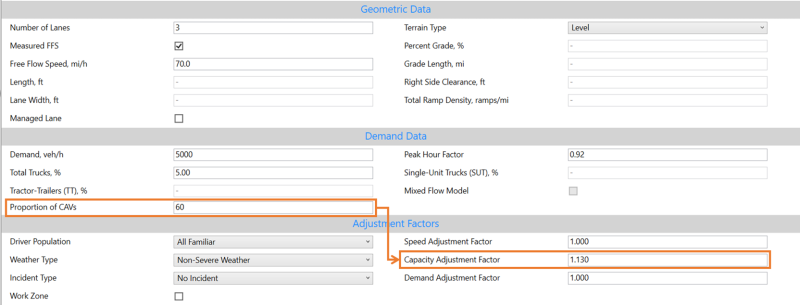The 7th Edition of the Highway Capacity Manual from a Practitioners’ Perspective
Connected and Automated Vehicles (CAVs) is a developing technology that holds great promise in reducing delays, crashes, and fuel consumption. The technology can communicate with each other and with the roadside infrastructure, allowing their driving systems to navigate and make decisions more efficiently and safely than a conventional human driver.
Given the early stage of its deployment, the scarcity of field data requires multiple assumptions when modeling CAV impacts on highway capacity, which leads to projections ranging from very conservative to very optimistic. This results in a myriad of scenarios that pose a challenge for public agencies that need to plan for the deployment of CAVs over the following decades to develop their long-range transportation plans and make policy and investment decisions.
The Transportation Research Board (TRB) will release the upcoming 7th Edition of HCM (Highway Capacity Manual), which will present, for the first time, methods to evaluate the capacity effects of CAVs in the freeways, signalized intersections, and roundabouts. This is an invaluable resource for agencies that now can rely on a nationally recognized, peer-reviewed reference manual for their long-range planning-level decisions. The upcoming Highway Capacity Software incorporates methods of CAVs analyses in the 7th Edition of HCM methods and will provide a user-friendly environment for practitioners to use these methods for long-range planning.
CAV Methods in the 7th Edition of HCM
The new methods can estimate capacity improvements as a function of the Market Penetration Rate –the percentage of vehicles in the traffic stream that has CAV capabilities. Higher penetration rates lead to higher capacity increases, consistent with research findings.
The 7th Edition of HCM will provide capacity adjustments for CAVs on freeways, signalized intersections, and roundabouts. These methods are intended for planning-level purposes and can measure CAV effects through a Capacity Adjustment Factor (CAF). Service Volume Tables are also provided, allowing for quick estimates of traffic volumes that can be serviced for given sets of road characteristics and a target LOS.
 HCS adjustments to segment capacity based on % of CAVs
HCS adjustments to segment capacity based on % of CAVs
CAV adjustment: Freeways
CAV effects on freeways are measured through a CAF applied to adjust the capacity of a given segment. Specific CAV tables are provided based on market penetration rate for basic, merge/diverge, and weaving segments. For example, with a 60% penetration rate of CAVs in the traffic stream, we can expect to gain 13% more capacity on a basic segment with a free-flow speed of 70 mi/h.
CAV adjustment: Signalized Intersections
The Signalized Intersections method will address the effects of CAVs by increasing the value of saturation flow rates as a function of the market penetration rate, with different adjustments applicable for the base saturation flow rate and protected and permitted movements. For example, with an 80% market penetration rate, the base saturation flow rate is expected to increase by 21%.
CAV adjustment: Roundabouts
CAV effects on the roundabout are modeled through adjustments on gap acceptance parameters that directly affect capacity: critical headway and follow-up headway. Higher market penetration rates should allow vehicles to accept smaller gaps and use them more efficiently, improving capacity values. For example, if there are 40% CAVs in a single-lane entry leg with a conflicting flow of 500 pc/h in a single circulating lane, the entry leg capacity will increase by 14%.
Conclusions
The HCM is the first widely recognized reference document to provide CAVs impact on various facility types. The Highway Capacity Software (HCS) will be ready to allow users to confidently model such a novel methodology, assuring accurate analysis faithful to the new HCM methods and facilitating the use of results and insights in the planning process of public agencies.


